
The rental market remained hot this January as the weakening home sales market motivated many would-be buyers to rent instead. While strong demand pushed up rents everywhere except for along the L train, the StreetEasy Manhattan Rent Index[i] reached a new high for the month of January and increased at the fastest pace in the city’s most expensive neighborhoods — particularly in Downtown Manhattan[ii] and northwest Brooklyn[iii], where rents rose by 2.4 percent and 3.5 percent, reaching $3,724 and $3,058, respectively.
Manhattan rent growth eclipsed Brooklyn and Queens again in January, which before late last year, which has not occurred since 2012. Manhattan rents rose to $3,204 — an annual increase of 2.6 percent, and the fastest annual pace since early 2016. Along with rising rents, rental concessions[iv] continued to fall across the city compared to the year before, deviating from the seasonal trend of discounts rising in the cooler months. In Manhattan, the share of rentals advertising concessions dropped at the fastest annual pace since 2010 – down by 8.6 percentage points annually to 13.2 percent.
“Manhattan home prices have reached lows we haven’t seen since 2015, and inventory levels are at historic highs, leading many to believe that now may be the time to buy. But with a median price above $1 million, purchasing a home in Manhattan is still too expensive for many in this market,” says StreetEasy Economic Data Analyst Nancy Wu. “Many would-be buyers are opting for the flexibility of renting in some of the most expensive areas of the city — which in turn is creating an unusually competitive winter rental season.”
See below for additional sales and rental market trends across Manhattan, Brooklyn and Queens.
January 2019 Key Findings — Manhattan
- Rents increased at the fastest pace since 2016. The StreetEasy Manhattan Rent Index increased 2.6 percent annually, reaching $3,204.
- The amount of landlord concessions dropped at the fastest annual pace since 2010. The share of rentals offering concessions fell by 8.6 percentage points since last year, with only 13.2 percent of rentals advertising concessions.
- Sales prices dropped at the fastest pace on record. The StreetEasy Manhattan Price Index[i] dropped 4.2 percent to $1,122,413 — the lowest level since 2015.
- The number of price cuts rose. The share of homes that had their price cut reached 14.9 percent in Manhattan – up 2.9 percentage points since last January. The share of price cuts in Upper Manhattan[ii] rose 7.1 percentage points, reaching 14.5 percent — the largest annual increase in the borough.
- Homes lingered on the market. The median days on market increased 11 days in Manhattan, reaching 111 days. Homes in Downtown Manhattan stayed on the market for a median of 120 days — 28 days longer than last year, and the longest period since early 2011.
January 2019 Key Findings — Brooklyn
- Rents continued to climb. The StreetEasy Brooklyn Rent Index increased 1.6 percent annually to $2,587. Rents rose in all submarkets except North Brooklyn[iii], where uncertainty over the canceled L train shutdown remained a factor. North Brooklyn rents fell 1.4 percent to $3,038.
- The share of rental concessions matched 2015 lows. Only 8.2 percent of rentals advertised concessions in January – down 10.6 percentage points from last year, and the lowest share since fall 2015.
- Prices were unchanged overall but grew in South Brooklyn. The StreetEasy Brooklyn Price Index remained the same as last year, at $706,832. Prices rose to $715,952 in the South Brooklyn[iv] submarket, up 3.7 percent from last year.
- More than 1,300 new homes were listed. Borough-wide, 40.3 percent more homes hit the market in Brooklyn than this time last year, with 1,313 homes added to the total inventory. This contributed to total inventory in the borough increasing by 28.8 percent.
- North Brooklyn homes spent nearly a month longer on the market. The median number of days on market in North Brooklyn increased by 27 in January, up to 104 days total. Borough-wide, the median time on the market rose 11 days to 101 days total.
January 2019 Key Findings — Queens
- Rents rose across the borough. The StreetEasy Queens Rent Index increased 2.4 percent annually, reaching $2,164. Rents rose the most in Northwest Queens[v], reaching $2,243 – up 1.6 percent from last year.
- Concessions were harder to find. The share of rentals advertising concessions dropped 5.2 percentage points in the borough – down to 9.1 percent. Rental concessions in Northwest Queens were down 5.9 percentage points, with 10.8 percent of rentals advertising concessions.
- Price growth slowed. The StreetEasy Queens Price Index increased 3.1 percent, the slowest annual pace since May 2017. Prices reached $515,966 — an increase over last year, but the lowest level in five months.
- Price cuts rose slightly. The share of homes with a price cut increased by 2.3 percentage points in January, with 9.0 percent of homes receiving a discount. Discounts were easiest to find in Central Queens[vi], where 10.7 percent of homes had a price cut — up 4.2 percentage points annually.
- Homes lingered on the market for an additional two weeks. In Queens, the median number of days on market increased by 14 to 92.5 days, the largest annual increase in time on market of the three boroughs.
View the complete StreetEasy Market Reports for Manhattan, Brooklyn and Queens with additional neighborhood data and graphics. See definitions of StreetEasy’s metrics and monthly data from each report.
[i] The StreetEasy Price Indices track changes in resale prices of condo, co-op, and townhouse units. Each index uses a repeat-sales method of comparing the sales prices of the same properties since January 1995 in Manhattan and January 2007 in Brooklyn and Queens. Given this methodology, each index accurately captures the change in home prices by controlling for the varying composition of homes sold in a given month. Levels of the StreetEasy Price Indices reflect average values of homes on the market. Data on the sale of homes is sourced from the New York City Department of Finance. Full methodology here.
[ii] The Upper Manhattan submarket includes Hudson Heights, Hamilton Heights, Washington Heights, Inwood, Fort George, West Harlem, Central Harlem, East Harlem, Manhattanville, South Harlem and Marble Hill.
[iii] The North Brooklyn submarket includes Greenpoint, Williamsburg and East Williamsburg.
[iv] The South Brooklyn submarket includes Sunset Park, Bay Ridge, Dyker Heights, Bensonhurst, Bath Beach, Gravesend, Borough Park, Ocean Parkway, Kensington, Coney Island, Brighton Beach, Ditmas Park, Seagate, Flatbush, Midwood, Sheepshead Bay, Manhattan Beach, East Flatbush, Canarsie, Flatlands, Marine Park, Mill Basin, Bergen Beach, Old Mill Basin, Greenwood and Gerritsen Beach.
[v] The Northwest Queens submarket includes Astoria, Long Island City, Sunnyside and Ditmars-Steinway.
[vi] The Central Queens submarket includes Woodside, Jackson Heights, East Elmhurst, North Corona, Elmhurst, Corona, Maspeth, Middle Village, Ridgewood, Glendale, Rego Park and Forest Hills.
—
Hey, why not like StreetEasy on Facebook and follow @streeteasy on Instagram?








